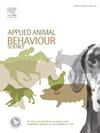Assessment of the behavior and suitability of primitive horse breeds for hippotherapy using the ‘Hippotest’ empirical test scale
IF 2.2
2区 农林科学
Q1 AGRICULTURE, DAIRY & ANIMAL SCIENCE
引用次数: 0
Abstract
Hippotherapy is a method of physical rehabilitation used to support many different human diseases and conditions with the help of horses. The appropriate selection of a horse as a co-therapist is a key factor in therapy with a patient. Horses of a wide range of different breeds and ages are typically selected for this type of rehabilitation. The study aimed to compare the behavior and reactions of horses of two primitive breeds that are not typically used in Hippotherapy outside of Poland: Hucul (hc) and Polish konik (kn), and determine their mental and physical predispositions to work in hippotherapy using an empirical test scale. Research observations following the Hippotest protocol were conducted on 20 horses, from two different equestrian centers. The research sample consisted of 9 geldings and 11 mares. The mean age of the horses in the sample was ± 7 years old. The horses’ behavior and reactions were observed using the eight trials in the Hippotest protocol. The behavioral assessment results based on the Hippotest’s empirical data were used in the statistical analysis of the Student’s t-test for one sample. Both breeds appeared to show they were suitable for hippotherapy work, while Hucul horses performed better (p > 0.05) than Polish koniks. The one of the test involving, the assessment of lunge movement showed statistical significance (p > 0.04) only for Hucul horses. The obtained results suggest that, regardless of their age, horses of these two primitive breeds show high predispositions to work in hippotherapy in terms of their behavior.
使用“Hippotest”经验测试量表评估原始马品种的行为和适合性
海马疗法是一种身体康复的方法,用于在马的帮助下支持许多不同的人类疾病和条件。适当选择马匹作为共同治疗师是治疗患者的关键因素。各种不同品种和年龄的马通常被选择用于这种类型的康复。该研究旨在比较两种原始品种的马的行为和反应,这两种马在波兰以外的地方通常不用于Hippotherapy: huul (hc)和波兰konik (kn),并使用经验测试量表确定它们在Hippotherapy中工作的心理和身体倾向。研究人员对来自两个不同马术中心的20匹马进行了研究观察。研究样本包括9匹公马和11匹母马。样本中马的平均年龄为± 7岁。马的行为和反应是通过Hippotest协议中的八个试验来观察的。基于Hippotest经验数据的行为评估结果用于单样本的Student’s t检验的统计分析。这两个品种似乎都显示出它们适合做海马治疗工作,而huul马比波兰科尼克马表现更好(p >; 0.05)。其中一个测试,评估箭步运动只有胡胡马有统计学意义(p >; 0.04)。所获得的结果表明,无论年龄大小,这两种原始品种的马在行为上都表现出高度倾向于接受海马疗法。
本文章由计算机程序翻译,如有差异,请以英文原文为准。
求助全文
约1分钟内获得全文
求助全文
来源期刊

Applied Animal Behaviour Science
农林科学-行为科学
CiteScore
4.40
自引率
21.70%
发文量
191
审稿时长
18.1 weeks
期刊介绍:
This journal publishes relevant information on the behaviour of domesticated and utilized animals.
Topics covered include:
-Behaviour of farm, zoo and laboratory animals in relation to animal management and welfare
-Behaviour of companion animals in relation to behavioural problems, for example, in relation to the training of dogs for different purposes, in relation to behavioural problems
-Studies of the behaviour of wild animals when these studies are relevant from an applied perspective, for example in relation to wildlife management, pest management or nature conservation
-Methodological studies within relevant fields
The principal subjects are farm, companion and laboratory animals, including, of course, poultry. The journal also deals with the following animal subjects:
-Those involved in any farming system, e.g. deer, rabbits and fur-bearing animals
-Those in ANY form of confinement, e.g. zoos, safari parks and other forms of display
-Feral animals, and any animal species which impinge on farming operations, e.g. as causes of loss or damage
-Species used for hunting, recreation etc. may also be considered as acceptable subjects in some instances
-Laboratory animals, if the material relates to their behavioural requirements
 求助内容:
求助内容: 应助结果提醒方式:
应助结果提醒方式:


